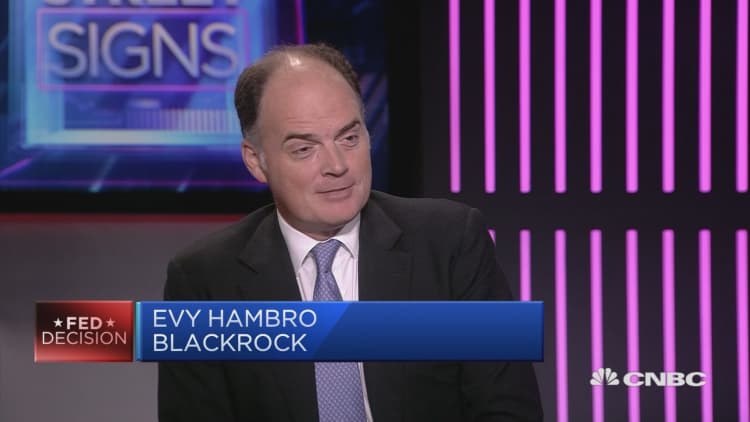Gold is trading near a six-year high following three straight months of gains, but Wednesday's announcement of a cut to interest rates by the U.S. Federal Reserve could provide the precious metal with even more price gains.
That's according to Evy Hambro, global head of thematic and sector investing at BlackRock, who says uncertainties surrounding risk assets and increasingly dovish monetary policy is likely to continue benefiting the commodity markets.
The Fed announced Wednesday that it would implement a widely expected cut of 25 basis points, its first rate reduction since the grip of the financial crisis in 2008.
Speaking to CNBC's "Street Signs Europe" ahead of the Fed's monetary policy decision on Wednesday, Hambro highlighted gold as an increasingly attractive diversification option for investors worried about elevated risks in broader equity markets. Fed Chairman Jerome Powell may have characterized the cut as a "midcycle adjustment" rather than the start of an aggressive cycle of monetary policy easing, but Hambro confirmed Thursday that his bullishness toward bullion was still applicable.

BlackRock projects that gold will be flat to rising over the next 12 to 18 months, with investment demand set to remain healthy in terms of futures positioning and flows of investment into physical gold and commodity-based exchange traded funds (ETFs).
"We're starting to see this momentum coming back into the market, strong flows into physical-backed ETFs," Hambro told CNBC.
"Gold prices today are not extraordinarily high relative to the cost of production. Most gold mining companies are profitable but they're not as profitable as, say, iron ore producers, who are making extraordinary levels of profitability, so I don't think it's that elevated in terms of price," he added.
Gold was trading at around $1,407.8 on Thursday morning, down from $1431.2 before Powell's announcement.
Dual functionality
Gold prices are positioned to rise in the current market environment thanks to two separate drivers, Hambro suggested, both as a currency and a commodity.
While the former attracts investment as a safe haven when the dollar weakens and equities become more risky, as is the case at present due to a range of trade and geopolitical concerns, the latter is all about supply and demand. At the moment, the latter is outstripping the former.
"When you look at demand for gold, it's very healthy today. It's driven partly by investment demand, but also jewelry demand remains pretty robust," Hambro said, adding that supply was the positive driver behind gold's current surge.
Gold mining capacity has endured under-investment for many years, he explained, due to "low levels of profitability and poor quality financing in the gold equity market." This has restricted the ability of the sector to generate new mining capacity, and combined with low levels of exploration success, the prospect of future supply is less promising.
"From a supply side point of view, you have a very strong foundation for the gold market," Hambro said.
He highlighted that gold mining companies have become much more disciplined in the way that they allocate capital, not only lowering new investment, but increasing the transparency of their investment decisions.
"For many years, we saw a boom in capital expenditure running in the last decade peaking in 2011, and since then you've seen this under-investment into new supply across all commodities, including gold," Hambro added.
He suggested that miners are now moving to assure investors that the past spending splurge is not going to repeat itself, resulting in a more disciplined approach to capital investment.
"That is likely to increase returns but also reduce supply growth, and in an environment where you have low levels of supply growth and decent demand, commodity prices tend to perform well," he said.
Longer-term, BlackRock anticipates that increasing Asian physical demand and plateauing mine production, as a result of reduced company spending, will drive up the price of gold.
"Meanwhile, given margins today, we expect gold equities to continue delivering a beta of above 1 to moves in the gold price over the next 12 - 18 months," Hambro added.

